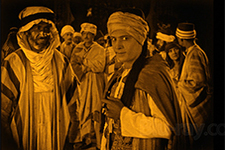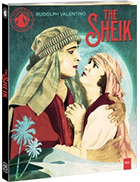The Sheik
|  If it you were reading a movie fan magazine on this day 100 years ago, chances are high that it would not have been long before you came across a smoldering, soft-focus image of Rudolph Valentino accompanied by a fawning article, interview, or sumptuous caption referring to him as “The Latin Lover.” Born Rodolfo Pietro Filiberto Raffaello Guglielmi di Valentina d’Antonguella in Italy, he immigrated to the United States in 1913 at the age of 18, and seven years later was one of the most highly sought-after movie stars of the silent screen, having solidified his on-screen persona as a mysterious, vaguely threatening, but ultimately irresistible sex symbol. He started playing bit roles in 1919, many of which hinged on his impressive dancing ability, and he became a star with his role in Rex Ingram’s The Four Horsemen of the Apocalypse (1921), which was a massive critical and commercial hit. At the time, Valentino was under contract with Metro, which seemed reluctant to give him true star billing, so he bolted for Famous Players-Lasky, which gave him the title role in The Sheik, a film ready-made to cement his status as a major movie star and an icon for the more risqué, Jazz Era morality of the Roaring Twenties. The Sheik was a presold hot property, being based on the first novel by Edith Maude Hull, which was first published in 1919 and quickly became an international best-seller, moving over a million copies worldwide and going through more than a hundred printings in its first four years. Hull’s novel was hardly an original or groundbreaking work, sitting squarely in the already popular subgenre of the desert romance; but, it offered perfect material for a smoldering film set against an exotic backdrop (as an ad in Variety touted, “The novel is the best seller of the year. Everybody’s reading it, everybody’s talking about it. It’s selling so fast they can’t print enough to take care of the orders”). The job of adapting Hull’s novel fell to Monte M. Katterjohn, who wrote more than 70 scripts between 1912 and 1931 (many of which were adaptations), but has been largely lost in the history books. Unfortunately, The Sheik has not aged particularly well, and not only because the creepy Stockholm Syndrome quality of the romance between Valentino’s Sheik Ahmed Ben Hassan and Lady Diana Mayo (Agnes Ayres), the British woman he takes captive, doesn’t play too well in the post-#metoo era. Rather, the film suffers because the direction by George Melford is so utterly unimaginative. By the early 1920s the silent film was reaching its apotheosis of artistry, with international filmmakers like D.W. Griffith, Giovanni Pastrone , Benjamin Christensen, Carl Theodor Dreyer, Abel Gance, King Vidor, F.W. Murnau, Victor Sjöström, and Fritz Lang having already successfully experimented with light and shadow, camera movement, editing, and other technical and aesthetic qualities and created films of great vision and artistry. The greatest films of the era—Pastrone’s Cabiria (1914), Griffith’s Intolerance (1916), Murnau’s Nosferatu (1922)—were dynamic, compelling, and aesthetically invigorating. The Sheik, on the other hand, is staid and languid, with Melford and cinematographer William Marshall generally content to lock the camera down and turn the heavy lifting over to Valentino melting Ayres’s first-wave-feminist feistiness into romantic submission against a backdrop of Arabian sand dunes (actually California’s Guadalupe-Nipomo Dunes, which also masqueraded as the Middle East in 1923’s The Ten Commandments, 1924’s The Thief of Bagdad, and 1930’s Morocco). And, for audiences at the time, it worked, as The Sheik was a major box office hit that propelled Valentino past stardom and into the realm of the iconic. And his immense popularity was not limited just to the United States. In 1925, the year before his untimely early death, the British fan magazine Pictures and the Picturegoer conducted a poll and found that Valentino was the “most popular screen star in the British isles.” There are certainly moments throughout the film that stand out, and Melford is not entirely lacking in a sense of humor (the scene in which Diana is chastised by a trio of older British ladies about her temerity in going into the desert alone with only a local guide is a humorous jab at upper-class priggishness). And, although much of the film’s sense of romance involves Sheik Ahmed objectifying Diana with his constantly widening eyes (an element of Valentino’s performance that was considered hypnotic at the time, but now just feels silly) and holding her physically against her will, there is something to be said for the film’s portrayal of Diana’s willingness to defy gendered conventions. Granted, she is ultimately tamed in the end, but to an extent, so is Sheik Ahmed. So, despite its iconic status in the history of American cinema, it is hard to muster much of a defense for The Sheik—narratively, aesthetically, or thematically. And it’s not like the film was a critical darling of its era. To wit, the opening sentences of the review in Variety: “Bad as this Lasky production now at the Rivoli and Rialto is, the public has nothing but the public to blame for it. Though by fear of censorship bled white of anything resembling human form, the popularity of Mrs. Edith M. Hull’s novel on which this picture is based should carry it past the box office a winner.” In other words, The Sheik is pretty terrible, but it will still be financially successful due to the novel’s popularity, which turned out to be exactly the case.
Copyright © 2021 James Kendrick Thoughts? E-mail James Kendrick All images copyright © Paramount Home Entertainment | |||||||||||||||||||||||||||||
Overall Rating: 
 (2)
(2)


